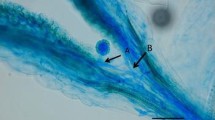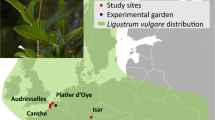Abstract
Unilateral pollen-pistil incompatibility within the Brassicaceae has been re-examined in a series of interspecific and intergeneric crosses using 13 self-compatible (SC, Sc) species and 12 self-incompatible (SI) species from ten tribes. SC x SC crosses were usually compatible, SI x SC crosses showed unilateral incompatibility, while SI x SI crosses were often incompatible or unilaterally incompatible. Unilateral incompatibility (UI) is shown to be overcome by bud pollination or treating stigmas with cycloheximide — features in common with self-incompatibility. Treating stigmas with pronase prevents pollen tubes from penetrating the stigma in normally compatible intra-and interspecific pollinations. The results presented show that the presence of an incompatibility system is important in predicting the outcome of interspecific and intergeneric crosses and, combined with the physiological similarities between UI and SI, would suggest an involvement of the S-locus in UI.
Similar content being viewed by others
References
Abdalla MMF (1974) Unilateral incompatibility in plant species: analysis and implications. Egypt J Genet Cytol 3:133–154
Bateman AJ (1954) Self incompatibility in angiosperms. III. Cruciferae. Heredity 9:52–68
Burnet FM (1971) Self-recognition in colonial marine forms and flowering plants in relation to the evolution of immunity. Nature 232:230–238
Chetelat RT, De Verna JW (1991) Expression of unilateral incompatibility in pollen of Lycopersicon pennellii. Theor Appl Genet 82:704–712
Christ B (1959) Entwicklungsgeschichtliche und physiologische Untersuchungen über die Selbststerititat von Cardamine Pratensis L. Z Bot 47:88–112
Corner EJH (1964) The life of plants. University of Chicago Press, London
De Nettancourt C (1977) Incompatibility in angiosperms. Springer, Berlin Heidelberg New York
De Nettancourt D, Devreux M, Laneri U, Cresti M, Pacini E, Sarfatti G (1974) Genetical and ultrastructural aspects of selfand cross-incompatibility in interspecific hybrids between self-compatible Lycopersicon esculentum and self-incompatible L. peruvianum. Theor Appl Genet 44:278–288
Dickinson HG (1990) Self-incompatibility in flowering plants. Bioassays 12:155–161
Dickinson HG, Lewis D (1973) Cytochemical and ultrastructural differences between intraspecific compatible and incompatible pollinations in Raphanus. Proc R Soc London Ser B 183:21–38
Doughty J, Hedderson F, McCubbin A, Dickinson HG (1993) Interaction between a coating-borne peopide of the Brassica pollen grain and S (incompatibility)-locus-linked stigmatic glycoproteins. Proc Natl Acad Sci USA 90:467–471
Elleman CJ, Willson C, Sarker RH, Dickinson HG (1988) Interaction between the pollen tube and stigmatic cell wall following pollination in Brassica oleracea. New Phytol 109:111–117
Ellis MF, Sedgley M, Gardner JA (1991) Interspecific pollenpistil interaction in Eucalytus L'Hér (Myrtaceae): The effect of taxonomic distance. Ann Bot 68:185–194
Franklin-Tong VE, Franklin FCH (1992) Gametophytic selfincompatibility in Papaver rhoeas L. Sex Plant Reprod 5:1–7
Gray JE, McClure BA, Haring V, Anderson MA, Clarke AE (1991) In: Hermann RG, Larkins B (eds) Plant molecular biology 2. Plenum Press, New York, pp 527–536
Hardon JJ (1967) Unilateral incompatibility between Solanum Pennnellii and Lycopersicon esculentum. Genetics 57:795–808
Harrison BJ, Darby LA (1955) Unilateral hybridisation. Nature 176:952
Heslop-Harrison J (1975) Incompatibility and the pollen-stigma interaction. Annu Rev Plant Physiol 26:403–425
Heslop-Harrison J (1982) Pollen-stigma interaction and crossincompatibility in the grasses. Science 215:1358–1364
Heslop-Harrison J, Heslop-Harrison Y (1975) Enzymic removal of the proteinaceous pellicle of the stigma papilla prevents pollen-tube entry in the Caryophyllaceae. Ann Bot 39:163–165
Heslop-Harrison J, Heslop-Harrison Y, Barber J (1975) The stigma surface in incompatibility responses. Proc R Soc London Ser B 188:287–297
Heslop-Harrison Y Shivanna KR (1977) The receptive surface of the angiosperm stigma. Ann Bot 41:1233–1258
Hodgkin T, Lyon GD, Dickinson HG (1988) Recognition in flowering plants. A comparison of the Brassica self-incompatibility system and plant pathogen interactions. New Phytol 110:557–569
Hogenboom NG (1972) Breaking breeding barriers in Lycopersicon. 5. The inheritance of unilateral incompatibility between L. peruvianum (L.) MILL. and L. esculentum MILL. and the genetics of its breakdown. Euphytica 21:405–414
Hogenboom NG (1975) Incompatibility and incongruity. Two different mechanisms for the non-functioning of intimate partner relationships. Proc. R Soc London Ser B 188:361–375
Knox RB, Clarke AE, Harrison S, Smith P, Marchalonis JJ (1976) Cell recognition in plants: determinants of the stigma surface and their pollen interactions. Proc Natl Acad Sci USA 73:2788–2792
Lewis D, Crowe LK (1958) Unilateral incompatibility in flowering plants. Heredity 12:233–256
Linskens HF, Esser K (1957) Uber eine spezifische Anfarbung der Pollenschläuche und die Zahl der Kallosapropfen nach Selbstung und Fremdung. Naturwissauschaften 44:16
Martin FW (1963) Distribution and interrelationships of incompatibility barriers in the Lycopersicon hirsutum HUMB. and BONPL. complex. Evolution 17:519–528
Martin FW (1964) The inheritance of unilateral incompatibility in Lycopersicon hirsutum. Genetics 50:459–469
Martin FW (1967) The genetic control of unilateral incompatibility between two tomato species. Genetics 56:391–398
Mattsson O, Knox RB, Heslop-Harrison J, Heslop-Harrison Y (1974) Protein pellicle of stigmatic papillae as a probable recognition site in incompatibility reactions. Nature 247:298–300
McClure BA, Haring V, Ebert PR, Anderson MA, Simpson RJ, Sakiyama F, Clarke AE (1989) Style self-incompatibility gene products of Nicotiana alata are ribonucleases. Nature 342:955–957
McClure BA, Gray JE, Anderson MA, Clarke AE (1990) Selfincompatibility in Nicotiana alata involves degradation of pollen rRNA. Nature 347:757–760
Nasrallah JB, Doney RC, Nasrallah ME (1985) Biosynthesis of glycoproteins involved in the pollen-stigma interaction of incompatibility in developing flowers of Brassica oleracea L. Planta 165:100–107
Nasrallah JB, Nishio T, Nasrallah ME (1991) The self-incompatibility genes of Brassica: expression and use in genetic ablation of floral tissues. Annu Rev Plant Physiol Plant Mol Biol 42:393–422
Nasrallah ME, Kandasamy MK, Nasrallah JB (1992) A genetically defined transacting locus regulates S-locus function in Brassica. Plant J 2:497–506
Pandey KK (1968) Compatibility relationships in flowering plants: role of the S-gene complex. Am Nat 102:475–489
Pandey KK (1969) Elements of the S-gene complex. V. Interspecific corss-compatibility relationships and theory of the evolution of the S-complex. Genetica 40:447–474
Pandey KK (1970) Time and site of the S-gene action, breeding system and relationships in incompatibility. Euphytica 19:364–372
Pandey KK (1979) The genus Nicotiana: evolution of incompatibility in flowering plants. In: Hawkes JG, Lester RN, Skelding AD (eds) Biology and taxonomy of the Solanaceae. (Linn Soc Symp Ser 7.) pp 421–434
Pandey KK (1980) Evolution of incompatibility systems in plants: origin of ‘Independent’ and ‘Complimentary’ control of incompatibility in angiosperms. New Phytol 84:381–400
Pandey KK (1981) Evolution of unilateral incompatibility in flowering plants: further evidence in favour of twin specificities controlling intra- and interspecific incompatibility. New Phytol 89:705–728
Roberts IN, Stead AD, Ockendon DJ, Dickinson HG (1979) A glycoprotein associated with the acquisition of the self-incompatibility system by maturing stigmas of Brassica oleracea. Planta 146:179–183
Roberts IN, Harrod G, Dickinson HG (1984) I. Ultrastructure and physiology of the stigmatic papular cells. J Cell Sci 66:241–253
Sampson DR (1962) Intergeneric pollen-stigma incompatibility in Cruciferae. Can J Genet Cytol 4:38–49
Sarker RH, Elleman CJ, Dickinson HG (1988) Control of pollen hydration in Brassica requires continued protein synthesis and glycosylation is necessary for intraspecific incompatibility. Proc Natl Acad Sci USA 85:4340–4344
Schulz OE (1936) Cruciferae-Brassiceae. In: Engler A, Harms H (eds) Die natürlichen Pflanzenfamilien 2, vol 176, pp 227–658
Shivanna KR, Heslop-Harrison J, Heslop-Harrison Y (1978) The pollen-stigma interaction: bud pollination in the Cruciferae. Acta Bot Neerl 27:107–119
Stein JC, Howlett B, Boyes DC, Nasrallah ME, Nasrallah JB (1991) Molecular cloning of a putative receptor protein kinase gene encoded at the self-incompatibility locus of Brassica oleracea. Proc Natl Acad Sci USA 88:8816–8820
Swinburne TR (1975) Microbial proteases as elicitors of benzoic acid accumulation in apples. Phytopathol Z 82:152–162
Tobias CM, Howlett B, Nasrallah JB (1992) An Arabidopsis thaliana gene with sequence similarity to the S-locus receptor kinase of Brassica oleracea. Plant Physiol 99:284–290
Walker JC, Zhang R (1990) Relationship of a putative receptor protein kinase from maize to the S-locus glycoproteins of Brassica. Nature 345:743–746
Whitehouse HLK (1950) Multiple allelomorph incompatibility of pollen and style in the evolution of angiosperms. Ann Bot NS 14:199–216
Williams EG, Rouse JL (1988) Disparate style lengths contribute to isolation of species in Rhododendron. Aust J Bot 36:183–191
Williams EG, Rouse JL (1990) Relationships of pollen size, pistil length and pollen tube growth rates in Rhododendron and their influence on hybridization. Sex Plant Reprod 3:7–17
Zuberi MI, Dickinson HG (1985) Modification of the pollenstigma interaction in Brassica oleracea by water. Ann Bot 56:443–452
Author information
Authors and Affiliations
Additional information
Communicated by H. F. Linskens
Rights and permissions
About this article
Cite this article
Hiscock, S.J., Dickinson, H.G. Unilateral incompatibility within the brassicaceae: further evidence for the involvement of the self-incompatibility (S)-locus. Theoret. Appl. Genetics 86, 744–753 (1993). https://doi.org/10.1007/BF00222665
Received:
Accepted:
Issue Date:
DOI: https://doi.org/10.1007/BF00222665




